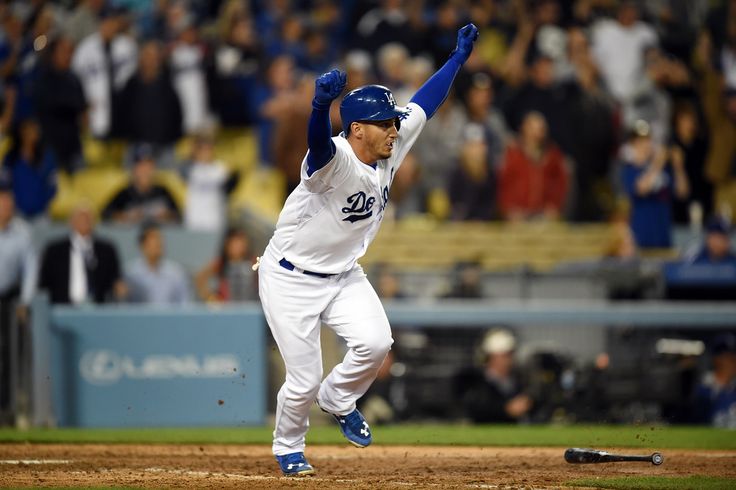
Alex Guerrero had three home runs, 11 RBIs and a .490 slugging percentage as a pinch hitter in 2015. (Hans Gutknecht/Staff photographer)
This is Part 19 of a series in which every member of the 2015 Dodgers has his season juxtaposed with an episode of the greatest sitcom of all-time. Don’t take it too seriously.
Alex Guerrero, 3B.
Key stats: 106 games, 230 PA (52 as a pinch hitter), .233/.261/.434 slash line.
Seinfeld episode: “The Beard.” (Season 6, Episode 16)
Key quote: “You think you can get him to just change teams? He’s not going to suddenly switch sides. Forget about it.”
It’s easy, and maybe not entirely unfair, to define Alex Guerrero’s first full major league season by what he didn’t accomplish. We’ll hash all that out in a minute, but first let’s take a second to appreciate what he did accomplish.
Guerrero demonstrated his value as a pinch hitter repeatedly, from a dramatic walk-off single in the 10th inning to beat Seattle in April, to a grand slam in the bottom of the ninth to beat Colorado in June.
Only one National League player, former Dodgers utilityman Skip Schumaker, had more pinch hit at-bats this year than Guerrero. While major league pinch hitters hit .216 as a whole, Guerrero batted .255 in 52 plate appearances with three home runs and 11 RBIs — both second in the NL. His .490 slugging percentage in pinch-hitting situations was among the best in baseball. For comparison, the man with the most pinch hit home runs in history, Matt Stairs, slugged .476 in his career as a PH. Guerrero found his talent in the second year of his four-year contract, and he found it at the end of the Dodgers’ bench.
When Don Mattingly was able to summon Guerrero to face a left-handed pitcher, or Andre Ethier to face a right-hander, the Dodgers were a much tougher team to beat in the late innings than they were in 2014.
Now, does that make Guerrero worth every penny of the $6.5 million he earned? No.
Does excelling at this singular skill excuse Guerrero from refusing an assignment to Triple-A to work on his all-around game? In the opinion of the Dodgers’ front office, probably not.
Will Alex Guerrero ever be able to play defense or draw walks consistently? Good question. Unless he’s a late bloomer at age 29, this might just be who he is.
Therein lies the rub. So far, Guerrero’s shortcomings have outweighed his strengths.
Between his turbulent year at Triple-A in 2014 and this year, the Dodgers have seen Guerrero attempt to play four positions: second base, shortstop, third base and left field. Of those, third base might be his best. He’s no more than an emergency fill-in at second or left (even though he started 27 games there), and he showed such little range at shortstop — his natural position — that the Dodgers haven’t allowed him to play an inning there in a regular season game.
If Guerrero’s glove doesn’t allow him to play an everyday position, maybe his bat can make up for it. This seemed to be the operating theory in May and June, when Guerrero got the bulk of his starts. He was the NL Rookie of the Month in April and was still slashing .300/.333/.678 as late as May 29. From that date onward — essentially the final two-thirds of the season — Guerrero’s slash line was .182/.204/.258. The more the league saw of him, the easier an out he was, and the more it seemed his approach wouldn’t fly without just a little more patience.
Guerrero’s contract has two noteworthy clauses. One allows him to become a free agent at the end of any season in which he is traded; the other allows him to refuse any minor-league assignment in 2015, 2016 or 2017. At some point, his trade value was limited more by his talent than any Scott Boras-created caveat.
Either way, unloading Guerrero to a team that needs a third baseman more than the Dodgers is no easy task these days. To pay his contract down to the point where it becomes more palatable to another team seems silly; it’s probably wiser to pay him millions to pinch hit for your team than someone else’s.
The situation isn’t entirely unlike the one Elaine finds herself in on a “date” with a gay man who doesn’t want his boss to know that he’s gay. It goes well. A little too well:
The angst of wanting more. So it was with Guerrero. He wasn’t just about to switch teams or master one of nine possible defensive positions or, most ideally, accept an assignment to Triple-A. He and the Dodgers were stuck with each other, each wanting more than the other was able to give.
